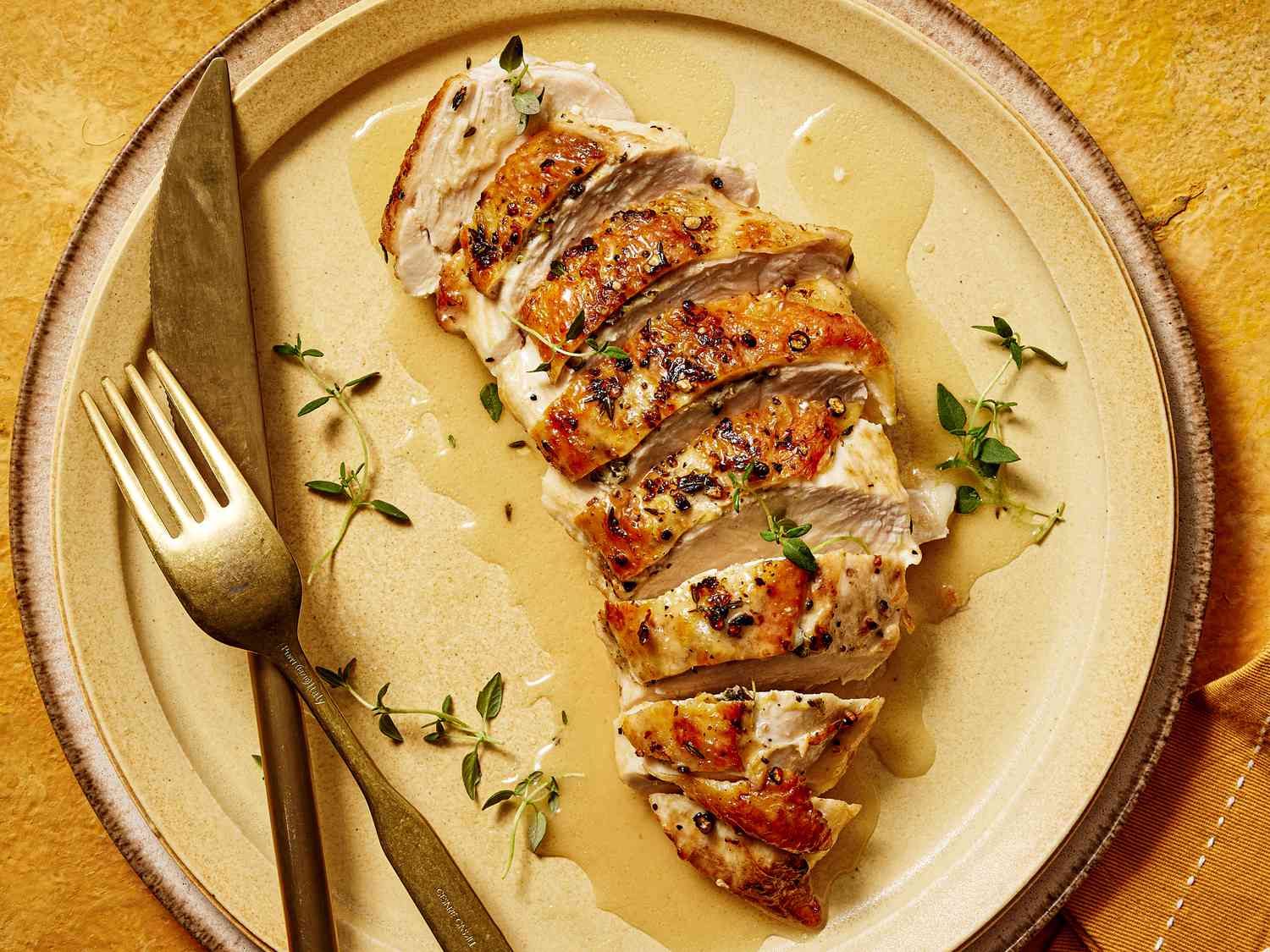
Why It Works
- Searing the chicken breasts before roasting them ensures golden, crispy skin once cooked.
- The combination of the roasted sweet lemon juice with fresh acidic lemon juice adds incredible complex flavor to the final sauce.
- Adding miso paste to the lemon sauce adds a savory boost while also thickening the sauce.
Pan-roasted chicken with a simple pan sauce—like this one with plenty of lemon and butter—is a wonderful weeknight dish. It’s delicious, requires just a handful of ingredients, and takes less than an hour from start to finish. Add a great roasted vegetable or simple salad on the side, and you’ve got one of my all-time favorite dinners that’s easy to prepare but impressive enough for company.
Serious Eats / Morgan Hunt Glaze
Of course, as with any simple food, the success of this skillet lemon chicken hinges on the execution. In developing this recipe, we wanted glistening, juicy chicken with crispy, brown skin and a rich, lemony pan sauce that clings to every bite. To guarantee these great results, our Birmingham, Alabama-based test kitchen colleague Julia Levy roasted batch after batch of chicken before landing on this foolproof one-skillet lemon chicken recipe below.
Key Techniques for the Ultimate One-Skillet Lemon Chicken
Julia didn’t stray far from a basic pan-sauce method here—the chicken is seared on the stovetop to crisp up the skin and then roasted in the oven; when the chicken is cooked through and golden brown, you’ll remove it from the oven and let it rest while you build a simple sauce right in the same pan. But to guarantee juicy chicken with a silky, deeply lemony sauce, she incorporated a few key techniques.
Use skin-on chicken breasts and monitor their temperature closely. With their lean meat, chicken breasts are notoriously easy to overcook. To keep the meat from drying out, we call for skin-on chicken breasts because the skin helps insulate the meat—and because crispy chicken skin is delicious. You’ll start them skin side down in a hot skillet and finish them in the oven, pulling them when an instant read thermometer reaches 155℉. As the chicken sits, carry-over cooking will cause the internal temperature to rise by about 10℉ to 165℉, the USDA’s recommended safe temperature for chicken breasts. By the time you slice into it, the chicken will be juicy and perfectly cooked.
Serious Eats / Morgan Hunt Glaze
Use a combination of roasted and fresh lemon when making the sauce. Chicken with lemon sauce is a classic pairing, but often the sauce lacks enough lemon flavor. To avoid a bland sauce, Julia found that a combination of fresh lemon juice and roasted lemon juice creates a complex and bright citrus-forward sauce. Searing two lemon halves and roasting them alongside the chicken transforms the lemon’s flavor from tart and acidic to caramelized and sweet. The combination of the roasted sweet lemon juice with fresh acidic lemon juice adds incredible complex flavor to the final sauce.
Enhance the pan sauce with miso paste and a medley of aromatics. To further guarantee a deeply flavored pan sauce, aromatics like garlic and thyme are added to the remaining fond in the skillet after the chicken is roasted. Julia’s secret ingredient for ensuring a savory and creamy sauce is white miso paste. Just one tablespoon packs a ton of umami flavor that balances the tart lemon flavor. We also love adding a hint of heat to the sauce with either a dried arbol chile or pinch of red chile flakes. While the recipe works well without both these ingredients, they add deep flavor and both are long lasting ingredients that are well worth having on hand.
Finish the sauce with butter to make it super silky. Just as important as building the sauce’s flavor is creating a velvety emulsion. Once the chicken stock is added and reduced by half to intensify its flavor, a few pats of butter are added as a finishing touch. The combination of stirring the sauce, swirling the pan, and vigorous bubbling will emulsify the butter into the sauce, breaking it up into tiny droplets that are then distributed and suspended evenly throughout the liquid, forming the emulsion.
Serious Eats / Morgan Hunt Glaze
Adjust as needed for a perfectly emulsified sauce. A properly emulsified sauce will look creamy, thickened, and opaque, and in order for that to happen, it needs to contain enough water. If the pan sauce looks thin and greasy, it’s broken—too much water has evaporated from the sauce, and it has over-reduced. To fix this, add just a few tablespoons of water to the sauce and continue swirling and stirring until it comes together, then immediately remove it from the heat. You can also read our overview of how to make a pan sauce for more detail on fixing the sauce.
The final silky, bright, lemony sauce is the perfect foil to the crispy chicken skin. It’s no wonder that chicken with lemon sauce is a classic pairing.
This recipe was developed by Julia Levy; the headnote was written by Leah Colins.
Trending Products










